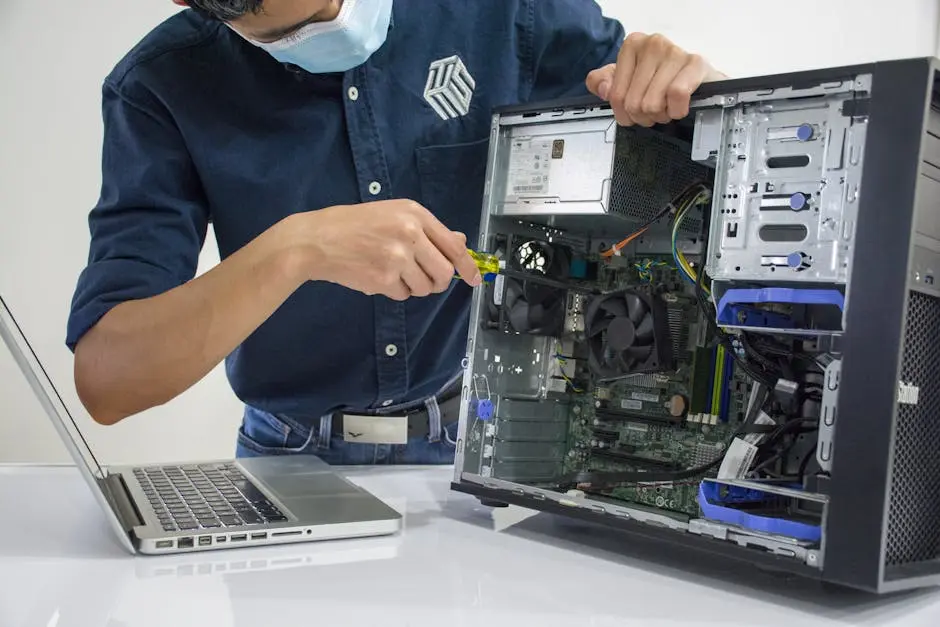Gaming PCs are not just machines; they are gateways to immersive worlds where adventures unfold. However, just like any piece of technology, they can run into issues that disrupt your gaming experience. This guide is here to help you identify some common gaming PC repair issues and provide simple fixes, making sure you’re back in the game without too much hassle.

Identifying Common Symptoms of Gaming PC Problems
Understanding the signs of a malfunctioning gaming PC is the first step in addressing any issues. From unexpected crashes to overheating, being able to identify symptoms will help you diagnose the problems effectively.
For instance, a sudden drop in frame rates can indicate a variety of issues, ranging from a bottleneck in your CPU to insufficient cooling. Observing these changes in performance allows you to act quickly.
Additionally, strange noises coming from your PC, such as grinding or buzzing, could be signs that your hardware is on the brink of failure. Paying attention to these auditory cues can save you lots of trouble down the line. Make it a habit to listen!
Lastly, frequent crashes or blue screens of death are often the most alarming symptoms. These events can often point to serious underlying problems, such as corrupted software or major hardware failures, which require your immediate attention.
Dealing with Hardware Failures
Hardware failures can be a gamer’s worst nightmare. Learning how to troubleshoot issues with components like your graphics card, power supply, and other critical parts of your gaming rig is essential.
First, check your graphics card. If you’re experiencing visual glitches or your games won’t run at all, it could mean your GPU is either failing or poorly connected. Removing and reseating your graphics card can resolve many connectivity issues, and it might be worth trying to clean any dust that has accumulated in the slot.
Another common issue is with the power supply unit (PSU). If your PC won’t turn on or shuts down suddenly during gaming sessions, the PSU might not be supplying enough power or could be failing. Ensure that all connections are tight and consider swapping it out with a known working unit to test if it’s part of the problem.
Hard drive failures are subtle and can manifest as slow load times or corrupt files. Utilizing diagnostic tools to monitor drive health can catch problems early. Regular backups can save you from data loss if a drive fails completely.
Resolving Software Glitches and Conflicts
Software issues can lead to performance drops or crashes. Understanding how to fix these glitches is crucial for maintaining an enjoyable gaming experience. We’ll take a look at common software problems and easy steps to fix them.
One of the first steps you should take is ensuring that your drivers are up-to-date. Outdated graphics drivers can cause a myriad of issues, from stuttering gameplay to crashes. Regularly checking the manufacturer’s website for updates or using dedicated software can save you from headaches.
Another issue that may arise is software conflicts—especially when new programs are installed. It can be helpful to look through your installed applications and see if anything new might be conflicting with your games. Trying a clean boot to isolate the issue may also be an effective strategy.
Additionally, ensure that your operating system is running efficiently by performing regular maintenance tasks, like disk cleanups and system updates. These actions can help in reducing lag and improving overall performance.
Boosting Performance with Regular Maintenance
Regular maintenance can prevent many common gaming PC repair issues. Discover simple practices that can keep your gaming PC running smoothly, ensuring an enjoyable and hassle-free gaming experience.
Cleaning your system inside and out is one of the easiest yet most effective maintenance steps you can take. Dust accumulation can impede airflow, leading to overheating and performance issues. A quick dust-off with compressed air every few months can make a significant difference.
Additionally, check the thermal paste on your CPU and GPU. If it’s dried out, it can lead to overheating, which throttles performance. Reapplying thermal paste may seem daunting, but it’s quite straightforward and worth the effort.
Monitoring your system’s temperatures can also prevent serious problems. Using software to keep an eye on temps can give you early warning signs that something isn’t right. If temperatures start to rise beyond normal levels, take action immediately.
Finally, regularly defragmenting your hard drive (if you’re using a traditional HDD) and managing your game files can help improve load times and overall performance. These small tasks contribute a lot to the longevity and efficiency of your gaming rig.
When to Seek Professional Help
While many issues can be resolved at home, sometimes it’s best to seek help from a professional. Knowing when to make that decision can save you both time and money.
If you’re unsure of a diagnosis or lack the tools to fix the issue, don’t hesitate to consult with a repair expert. It’s better to seek help than risk damaging components further. A professional can offer you solutions that you might not have considered.
Look for reviews and recommendations when choosing a repair service. It’s essential to find a trustworthy service provider who understands your specific gaming PC needs. A good repair technician can guide you through both short-term fixes and long-term solutions.
Lastly, remember that some issues, such as motherboard failures or intricate system conflicts, can be particularly challenging to resolve on your own—even for experienced users. In these cases, opting for professional help is a straightforward path to getting your beloved gaming PC back in action.
Wrapping It Up
With a bit of knowledge and patience, most gaming PC repair issues can be tackled without needing to call a professional. Remember, regular maintenance and understanding your system’s workings will go a long way in ensuring a smooth gaming experience. Keep this guide handy, and happy gaming!